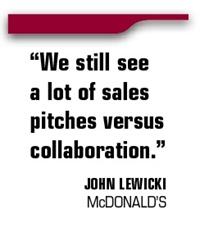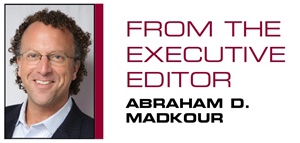I keep hoping to hear something different. For more than 20 years, I’ve heard the familiar refrain from brands regarding sports properties: They just want to sell us and don’t get us. Maybe it’s to be expected; perhaps properties and brands will always be at arm’s length and discouraged by each other — I’ve heard plenty of properties bemoan the lack of activation from brands. It may be the buyer/seller dynamic, but it prevents true partnership. Recent discussions I’ve had with some veteran brand-side marketers indicate there is still work to be done, especially at the team level.
“There are definitely properties that are better at it than others,” said John Lewicki, McDonald’s head of global alliances, speaking at our recent Sports Marketing Symposium. “At the team level, we still see a lot of sales pitches versus collaboration. You would hope that it would move more quickly than it has. We’re seeing some of that, but the industry as a whole needs more collaboration between brands and partners as we sit down and look at deals.”
Greg Via, Gillette’s global director of sports marketing, sounded more discouraged. “I’m seeing things now that I saw 15 years ago,” said the sports marketing veteran. “I don’t know if it’s the pressure from the teams, because it’s not the leagues so much. It’s teams or individual properties that are not paying attention to what they’re doing. I don’t know why, maybe it’s the sales pressure. But putting the wrong name on a deck — ‘Dear Jim’ instead of ‘Dear Greg.’”
 |
Lewicki noted a recent pitch that told the McDonald’s marketer, “This would be a great opportunity for Papa John’s.” Via also questioned the sales strategy of some teams, saying, “Over the last month, I’ve actually felt like I’ve been threatened several times by, ‘We’re going to give you the first offer here. We’re actually talking to your competitor, but just because we respect you so much, we’re going to give you an opportunity to come in and bid.’ Well, thank you very much, but just go ahead and sell it. If I hear that, that shuts the door pretty much immediately. I don’t know where that’s coming from.”
Former Coca-Cola marketer Scott McCune wasn’t surprised when told of the comments, believing team sales executives don’t have a goal of creating shared value between the team and brand, but instead focus only on the transaction. “Look at the compensation model from a team sponsorship. Most of it is based on what they sell, not what they create in shared value,” he said.
Momentum Worldwide’s Mike Sundet, who spent years on the brand side with Anheuser-Busch before joining an agency less than a year ago, said he’s especially frustrated by the lack of understanding and customization by properties. “One of my pet peeves is when I get the pitch of somebody saying, ‘I want to understand your objective so I can tell you why this fits,’” he said. He implored properties, “Do your homework, come in with something that works.”
Hearing this, the NBA’s senior vice president of business development, Rachel Jacobson, noted a strategy at the league in fostering better understanding between sides: collaborative sessions before a deal gets signed. “One of the things that we did with Pepsi before the partnership even started was we had chemistry sessions with them. We literally had their agencies, key colleagues across their organization, not just their business development team, but all departments, meet. We spent a lot of time meeting collectively to come up with key areas that were going to be part of this partnership.”
If a goal of a sponsorship is to create shared value, could a pay-for-performance model provide incentive for the relationship, where both sides drive incremental sales? There was disagreement as to whether this long-discussed concept could work. I don’t believe properties would risk long-term, consistent revenue for possible variance, and I am concerned that the concept is so subjective and there are too many variables in the mix for it to work effectively.
But Sundet believes it fits for some brands.
“We’re a big fan of building in a pay-for-performance or some kind of [key performance indicator] where the partner is tied to our business objectives,” he said. “If part of the payment or the bonus payment is tied to our business objectives, it ensures that we’re going to have that collaboration. They’re going to want to understand our business objectives, how our businesses work and do everything in their power to help market that.” The performance metric could vary. “It can be sales, or tied to awareness for a new brand or brand image objectives or impressions or activations,” Sundet said. “It doesn’t have to be directly to sales because there are things that are outside of a property’s control. The key is putting in objectives that the partner can help a brand meet. That fosters that spirit of partnership.”
 |
But Lewicki noted challenges to such a model. “For a traditional packaged goods company, you can see unit sales. But I’m not creating an NFL or NBA burger and looking how that sells. I’m looking to engage our customers in a different way. We’re looking at relevancy, we’re looking at authenticity, we’re looking at brand health, we’re looking at how people engage with us and engage across multiple platforms to come into our restaurants. It’s not just a straight sales target.”
Via said it’s a concept he’s been pushed on but has rebuffed. “I’ve declined to participate in those and in athlete pay-for-performance deals — win a gold medal, get a bonus. I stay as far away from those as I can.” Via also flipped the example to on-field performance. “I’ve had teams say, ‘If we win the championship, you give us a bonus.’ I said, ‘Well, if you don’t win the championship, I want a rebate.’ You can imagine how those conversations go.”
Lewicki laughed and offered his own example of renewal talks with an unnamed NFL team that come off a terrible 2-14 record but were asking for a rights fee increase. “We said, ‘Justify your increase.’ They looked at us and said, ‘Well, because we’re big and all this other good stuff.’ We said, ‘Yeah, but you went 2-14 last year. What is the benefit to us to continue with you?’ They only said, ‘Well, we’re going to get better.’” Via then envisioned an entirely different sponsorship model. “I look at what we do for a league or a property or a partner,” he said. “If I’m able to put you in 198 countries and in thousands of retail locations, that’s worth something. It sounds arrogant, but some of these properties I feel should be paying us because of what we are doing for their brands in locations they are not used to being in. We are helping you sell merchandise and expand your fan base. I know that’s not realistic. But we perform at a high, high level, and we expect that partner to do the same.”
Lewicki concurred, “We do a lot for brands. That point gets lost a lot. We communicate and help associate that brand in a lot of our distribution channels. It needs to be a partnership. It cannot be just we’re selling inventory. There has to be that symbiotic relationship where you are working together for the greater good for both.”
This isn’t intended to bash today’s property/team sales strategy, but just to foster communication on where the relationship can be improved — to Lewicki’s point — for the good of both sides. If you have thoughts, questions, comments or ideas, please share them, because I keep hoping to hear something different.
Abraham D. Madkour can be reached at amadkour@sportsbusinessjournal.com.






